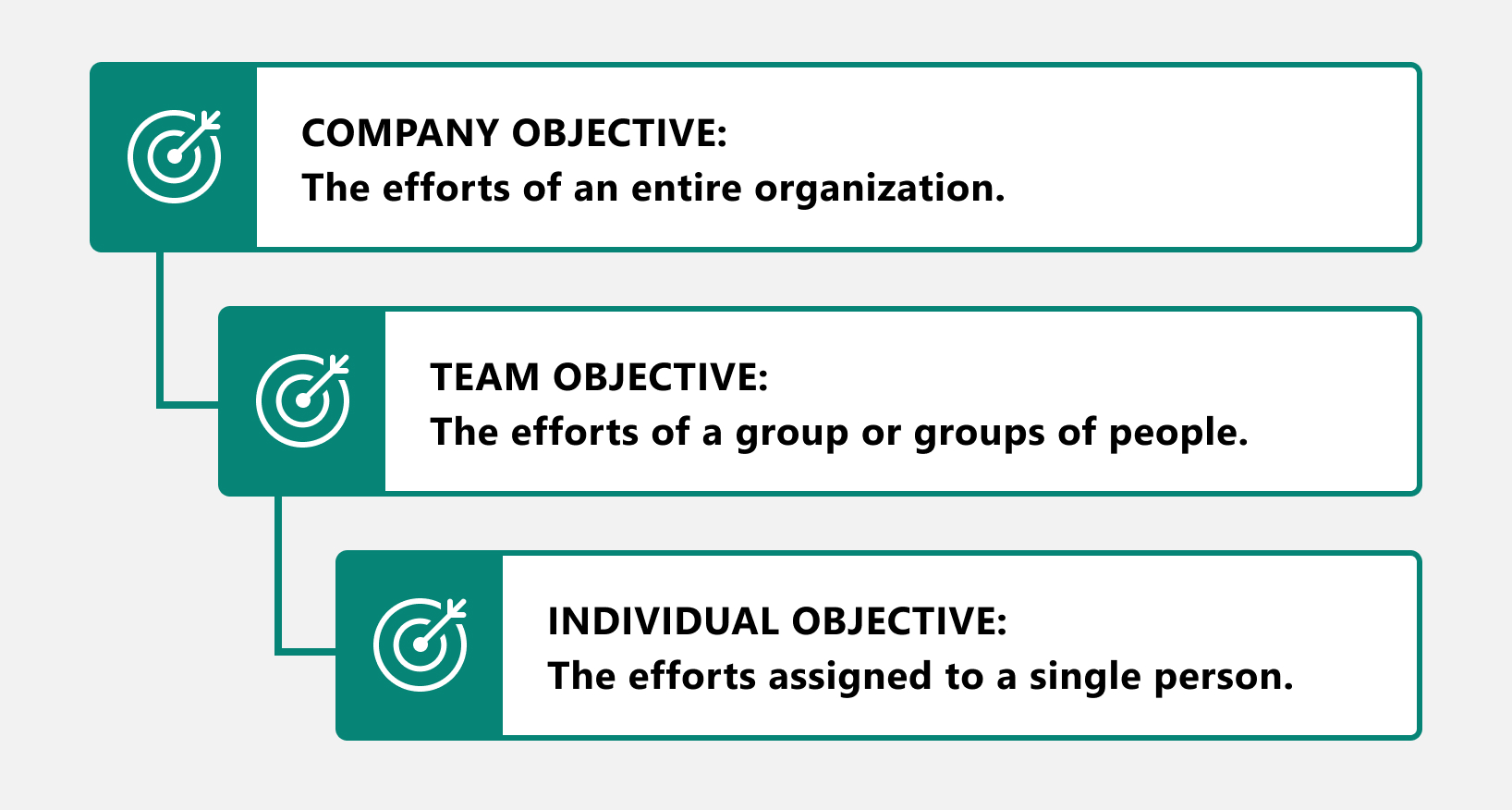OKR levels and alignment
When it comes to writing your OKRs, there's one final element that transforms these disparate ideas into one cohesive business framework, and that is the concept of alignment. Alignment helps dictate how progress rolls up from the work of a single individual all the way up through your organization to the biggest, aspirational, company-wide Objective.
To begin thinking about alignment, we need to be aware of the different levels of OKRs, which help to dictate the scope of your goals. Each level has its own mindset, or way to approach writing, so that all the elements can be added together to create a whole. Those levels are:
- Company: The efforts of an entire organization.
- Team: The efforts of a group or groups of people.
- Individual: The efforts assigned to a single person.

Company level
Best practice is to start from the top with the senior leadership team. Their first mission is to map out annual organizational Objectives, dictating the most important 3-5 goals that the company wants to achieve in the coming year.
Senior leaders should set aside enough time to give these goals serious thought. After all, you're mapping the future direction of the company, below which every team member will align.
Picture yourself hosting a lavish New Year's Eve party for all your employees, and all the departments are celebrating the massive success you've had this year. The clock is winding down, and in the 3-5 minutes you have before the end of the year, you're going to address the crowd and summarize the goals you've achieved for the year. What is the story you tell?
In other words, if you could look back at the end of the year and only accomplish 3-5 things... what would make the most dramatic impact on your business? Ask yourself:
- Where are we going?
- How are we getting there?
- What do I have to do to get there?
These answers will form your company wide OKRs.
Team level
Now we need to connect our team level goals to these organization level goals. By teams, we mean group efforts. These groups could be departments, functional teams or subteams, business units, or some combination of a group or groups of people who are delivering focused efforts that should roll up to the company.
Just like with company-wide goals, we're going to follow the same steps of asking ourselves "Where are we going" to identify the areas of focus for our Objectives, and "How are we getting there?" to identify the areas of focus for our Outcomes/Key Results. Some teams might even go one step further and ask themselves "What do I have to do to get there?" and come up with Projects, or a list of tasks/outputs, that will underpin their Key Results to support execution.
Here are some critical things to remember:
- Metrics for teams should be things the team can influence.
- Don't set a metric of generating 1,000 attendees at a webinar, if the team has no influence on generating those leads. Instead, focus on what the team can control firstly, or build influence with the teams that can help achieve the attendance goals if that is what matters to company success.
- Focus first on the primary point of alignment.
- Ask yourself "Why" a company-wide Objective or Key Result is being done and identify what you can do to make that happen. Why do we want to lead the market? So we can beat the competition. How can my team help beat the competition?
Individual level
Finally, we need to align our team level goals down to the individual level. Many companies only set OKRs at the organization and team levels, especially when just starting out, meaning that the individual level represents goals that are assigned to users from the team level. Other companies may choose to allow users to set individual OKRs.
The critical thing to ask yourself is, "Are my actions moving the needle, or am I just replicating my regular job duties?"
Remember, OKRs aren't a task list or a to do list. If all you can think of is a series of tasks, then your Individual goal should be a Key Initiative/Project that supports another person's outcome. It's okay for a single individual not to have a Key Result if their efforts are better tracked as a Key Initiative/Project.